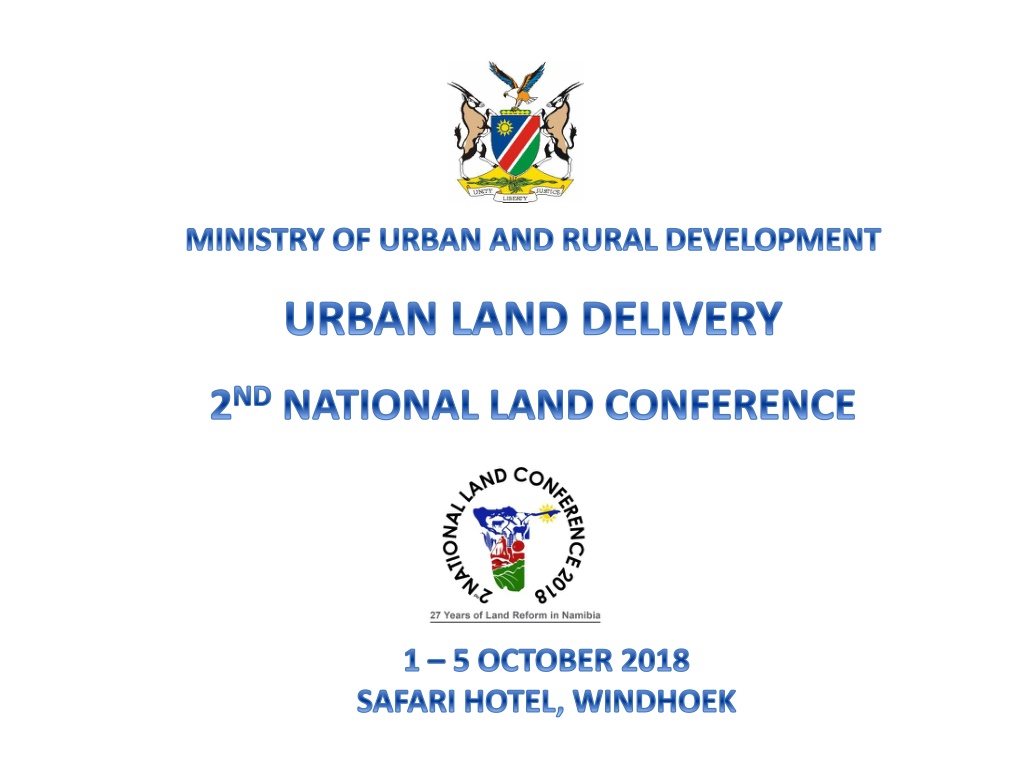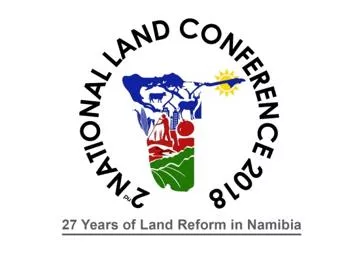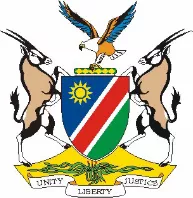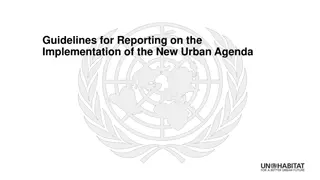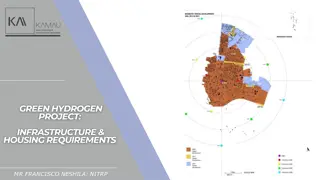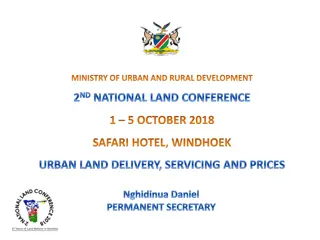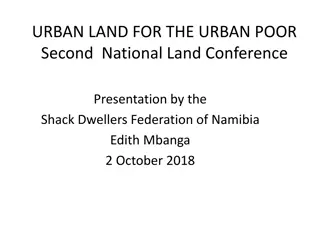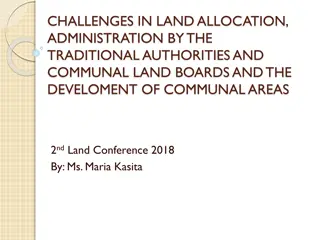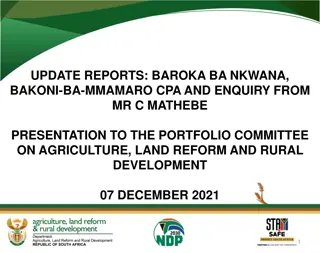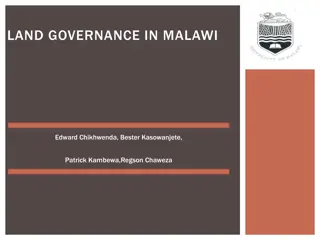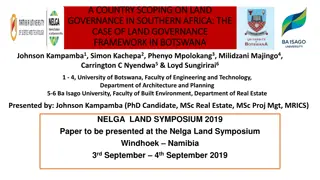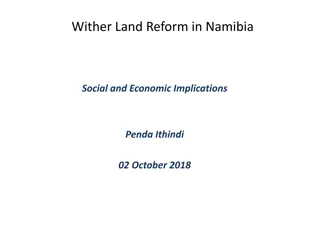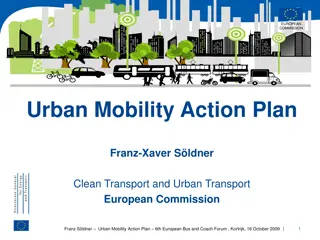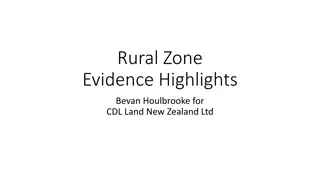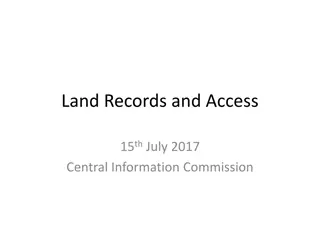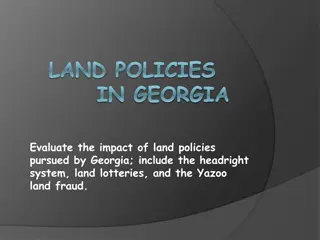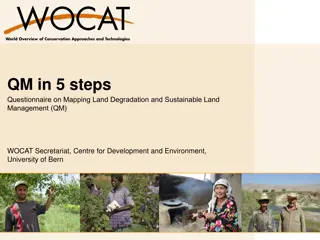Overview of Urban Land Development Challenges
Urban land development in Namibia has faced historical disparities, leading to challenges in post-independence policy interventions. Issues such as urban segregation, lack of municipal services, and backlog in housing supply contribute to the complexities of urban planning and development in the country.
Uploaded on Mar 01, 2025 | 0 Views
Download Presentation

Please find below an Image/Link to download the presentation.
The content on the website is provided AS IS for your information and personal use only. It may not be sold, licensed, or shared on other websites without obtaining consent from the author.If you encounter any issues during the download, it is possible that the publisher has removed the file from their server.
You are allowed to download the files provided on this website for personal or commercial use, subject to the condition that they are used lawfully. All files are the property of their respective owners.
The content on the website is provided AS IS for your information and personal use only. It may not be sold, licensed, or shared on other websites without obtaining consent from the author.
E N D
Presentation Transcript
MINISTRY OF URBAN AND RURAL DEVELOPMENT URBAN LAND DELIVERY 2NDNATIONAL LAND CONFERENCE Related image K 1 5 OCTOBER 2018 SAFARI HOTEL, WINDHOEK
Related image OUTLINE Overview Policy interventions Post 2nd National Land Conference interventions Conclusion
Related image Overview Pre-Independence The urban sector was characterised by: The development of urban areas that were not proclaimed as local authorities or townships; Town or urban planning and development was geared towards the needs of minority white population resulting in the white population having access to and ownership of urban land and the suburbs designated for whites being well developed in comparison to the majority black population; The blacks did not have the right to own urban land and settled in townships (informal settlements), which lacked the basic municipal services, heavily regulated and their expansion was prohibited, resulting in overcrowding (backyard habitation and squatting).
Related image Overview (cont..) Post-independence End of apartheid rule and laws that restricted the movement and settlement of non-whites in certain parts of the country, An increase in or free movement of people from rural and peri-urban areas or small and less developed areas to urban especially major urban in the hope of finding employment and a better life. The Urban Land and Housing Sector is characterised bya huge backlog in the supply of and demand for serviced land and housing in urban areas in particular and the country in general A high rate of urbanisation (50% from 28% at independence) and consequent high demand for land and housing in urban areas Pressure and inability of local authorities to provide services and infrastructure (land and housing) to meet the demand. The landless and poor are pushed to settle in the outskirts or informal settlements with no basic municipal services
Related image Challenges (Backlog) Causal Factors: 1. Low or slow delivery or supply rate due to: High input costs (material, labour, services, etc.) versus low budgetary or funding resources; Weak or lack of integrated and pro-active urban planning (master plans) setting out short, medium and long term planning and development targets, timeframes and implementation strategies; Cumbersome or lengthy administrative and legal procedures of acquisition,planning and development of urban land (proclamation of townships, surveying, subdivision, servicing, disposal and registering of immovable property); Limited or weak institutional and technical capacity (urban/town planners, surveyors, engineers, etc.) at the Central and local government to plan and delivery services at the required rate to meet the demand;
Related image Challenges (Backlog) (cont..) Causal Factors 1. Low or slow delivery or supply rate due to (cont..): Heavily reliance on conventional construction materials, technologies and methodologies which in some instances are expensive and cumbersome to acquire or use; Slow or delayed execution of projects due to among others delays in procurement of contractors or project managers or implementation capacity challenges and poor performance on the part of contractors and project managers; Overlaps or lack of clarity between the jurisdictions of Government (Central, regional and local) and traditional authorities resulting in conflicts and disputes and consequent delays in execution of planned capital projects in some cases; and Local authorities having reached their set townland boundaries and no longer have any land to service and provide, requiring the acquisition of either communally occupied or privately owned farmland (compensation).
Related image Challenges (Backlog) (cont..) Causal Factors 2. Affordability by the target end users: A mismatch between the types and pricing of housing products that are available in the market on the one hand and the needs and affordability levels of a large section of the needy on the other hand, especially the low to middle income earners; Limited affordable housing financing facilities especially for the low to middle income groups; The stringent and rigid lending requirements of the financial market that require collateral security, and the inability of the low and lower income earners to meet such financing requirements; Unemployment and poverty, which reduce potential buyers purchasing power; Overpricing and speculative activities by some developers due to a lack of enforcement of regulatory controls on pricing; Unclear or lack of transparency and inclusivity in the manner or methods in which land (serviced or un-serviced) that is earmarked or available for sale by local authorities is communicated to the broad public.
Related image POLICY INTERVENTIONS Policy & Legal Instruments: Namibia Housing Policy of 1991 (revised in 2009); Local Authorities Act (Act No. 23 of 1992 as amended); Regional Councils Act (Act No. 22 of 1992 as amended); National Housing Enterprise Act (Act No. 5 of 1993); National Housing Development Act (Act No. 28 of 2000); Trust Fund for Regional Development and Equity Provisions Act (Act No. 22 of 2000); New Urban and Regional Planning Act (Act No. 5 of 2018); Flexible Land Tenure Act of 2012 (Act No. 4 of 2012); Adoption of a Compensation Policy, which provides for fair compensation to communal landholders
Related image POLICY INTERVENTIONS (cont..) 2. Targeted Programmes 2.1 Establishment / Proclamation of Local Authorities 42 new Local Authorities from 15 at independence 411 townships (extensions) proclaimed since independence translating into some 123,400 plots countrywide; 2.2 Land Servicing 33,619 plots serviced during 2013/2014 to 2017/2018 FYs 2.3 Alienation Scheme - 4,000 houses were transferred/ sold to the tenants 2.4 Build Together Programme (BTP) 30,400 housing units have been constructed under this Programme since inception (1992)
Related image POLICY INTERVENTIONS (cont..) Targeted Programmes cont.. 2.5 Mass Housing Development Programme (MHDP) 3,726 houses in various categories completed since the inception of the Programme in 2013, 750 more houses under construction 2.6 Financial Support to Community-Based Housing Organisations N$44,7 million grant funding to the SDFN which has enabled the construction of some 1,901 affordable houses 2.7 Informal Settlement Upgrading Programme Implementation of Flexible Land Tenure System Participatory Slum Upgrading Programme 2.8 Private Investment and Public Private Partnerships (PPPs)
Related image Budget - Expenditure Financial Year Compensation Land servicing 2013/2014 50,000,000 739,099,000 2014/2015 120,000,000 698,359,000 2015/2016 100,000,000 1,019,811,000 2016/2017 50,000,000 797,500,000 2017/2018 30,000,000 523,100,000 2018/2019 12,000,000 683,180,155 Total 362,000,000 4,461,049,155
Related image INTERVENTIONS: POST 2NDNATIONAL LAND CONFERENCE Pro-active, integrated and inclusive development approach Post 2nd National Land Conference Interventions Demand- driven Approach Active Role of Government Private Sector s Participation in Affordable housing
Related image 1. Pro-active, integrated and inclusive development approach Development of Structural/Master Plans; Development of a Database and information management system on urban land and housing; Development of institutional capacity and skills in urban land and housing; and Reduced reliance on private professionals use of professionals in government including LAs/RCs as well as graduates/interns
Related image 2. Demand-driven Approach Participatory inputs from target community at design and development stages; Incremental development and provision of services taking into account the affordability, needs and priorities of beneficiaries; Densification and upgrading; A provision for rental housing with an option to own
Related image 2. Demand-driven Approach (cont..) Recommendations Expedite the roll out of the Flexible Land Tenure System and Act of 2012 and the Massive Urban Land Servicing Project (MULSP) and the revised MHDP Blueprint and Implementation Strategy; Expansion of local community participation in the housing process to both create economic opportunities and develop a demand-driven approach to housing delivery through among others continued grant funding to community group saving schemes (SDFN) Enhance affordability by for low income earners by among others: Providing for rental-to-own housing development as well; Adopting affordable incremental design/layouts andbuilding methods - For example byleaving out the nice-to-have finishes to be added on by beneficiaries when their income permits and thereby giving them the opportunity to give their own character to the house;
Related image 2. Demand-driven Approach (cont..) Recommendations (cont..) Pre-allocation of (un-serviced) - Land with only a few of the basic services (planned, surveyed and perhaps only serviced with sewer and water in the first phase and other services to follow later); and Introduction and enforcement of discriminatory pricing of land and cross- subsidisation.
Related image 3. Private Affordable housing Sector s Participation in Private sector participation in the provision of serviced land and low income (social) housing to reduce the backlog; and Private land and housing development must follow approved urban Master Plans Recommendations: Encourage more PPPs in the servicing of urban land and housing in line with the provisions of the Public-Private Partnership Act, 2017 and on the basis of Clear pre-determined targets (beneficiaries, product types and prices); Open and competitive procurement; and Fair distribution of risk or costs and benefits between the Government and private developers; Regulation of the sale of land to private developers especially to prevent land speculation and sale of large tracks of land to a few individuals and developers; and Local authorities should develop appropriate institutional capacity to guide, monitor and ensure integrated land use planning and urban development as well as environment protection.
Related image 4. Active Role of Government Government acting as a provider instead of a facilitator of serviced land and housing; Government s role: Allocating, consolidating, acquiring and planning land is key for promoting housing that is affordable to the Low Income/ Groups (LIG); Ensuring appropriate and effective national policy, legal and regulatory framework on land and housing delivery; Development and implementation of urban land and housing database and information management systems (planning tools); Redefine the role of the National Housing Enterprise (NHE), its strategic direction and target market with a view to re-position and capacitate the NHE to enable it to effectively perform its assigned housing financing and development role.
Related image 4. Active Role of Government (cont..) Recommendations: Amend the Local Authorities Act, 1992 and the Regional Councils Act, 1992 to insert a provision prohibiting the sale of land to foreign nationals, and obliging those who are already in possession of urban land to give the State the first right of refusal when they want to bequeath; Continued role of Government (Central and sub-national governments) as a land provider for affordable housing targeting the ultra and low income groups; Revision of the National Housing Development Policy 2009 and the National Housing Act (Act no. 33 of 2000) in order to make them responsive to the current housing situation and needs; MURD (stakeholders consultations on) to finalise the review of the Blueprint on the Mass Housing Development Programme (MHDP) and development of an Implementation Strategy (review already underway with the help of NUST);
Related image 4. Active Role of Government (cont..) Recommendations (cont..) A Continued financial and technical support to regional councils and local authorities as well as the NHE towards land and housing delivery with specific set conditions and deliverables such as: The target groups (low income and other considerations); Specifications (costs, sizes, etc.) of the products or services to be realized; and The establishment of dedicated revolving funds/accounts, to be audited periodically by MURD and the Office of the Auditor General, into which proceeds from the sale of serviced land and houses are to be deposited for re- investment; Development and/or enforcement of appropriate legal instruments that protect both landlords and tenants - Tenants against arbitrary rental increases and guarantees an agreed level of service and maintenance, and the right for the landlord to collect on delinquent rent and the power to evict non-compliant tenants; Implementation of Business Process Re-engineering (BPR) in the urban land and housing planning, approval and delivery processes at all levels;
Related image 4. Active Role of Government (cont..) Recommendations (cont..) MURD with technical support from NSA to conduct a study onindigent people in urban areas who are not in possession to pay for municipal services with a view to enable government to develop a viable incentive scheme; MURD, with the support of the Ministry of Justice and Office of the AG, to expedite the finalisation and promulgation of the regulations to operationalise the Urban and Regional Planning Act, 2018; MURD in partnership with the Ministry of Industrialisation, Trade and SME Development and institutions of higher learning (UNAM and NUST) to carry out research and development with a view to identify and promote the manufacturing and use of cost-effective building materials and technologies that meet set quality and safety compliance standards;
Related image 4. Active Role of Government (cont..) Recommendations (cont..) Local authorities and regional councils, with support from MURD and other relevant authorities and agencies, to develop and put in place up-to- date database on available serviced and un-serviced urban land as well as verifiable lists of people in need or those who applied for serviced land and housing support; Government, through MURD and MLR, should finalise the review of the land compensation valuation and implementation guidelines in order to respond to current needs and developments in respect of land compensation and acquisition; A revision of the current role and strategic direction of the NHE with a view to re-position, capacitate and enable the company to enable it to effectively perform its assigned housing financing and development role as part of the overall housing delivery agenda, yet in a more targeted approach
Related image TRADITIONAL AUTHORITIES AND AREAS OF JURISDICTIONS Administration of Traditional Authorities matters are governed and regulated by the Traditional Authorities Act, 2000 (Act No. 25 of 2000), and the Council of Traditional Leaders Act, 1997 (Act No. 13 of 1997); Land under traditional authorities is administered and regulated under the Communal Land Reform Act, 2002, which is administered by MLR; The Government is confronted with situations of: Some recognition of Traditional Authorities (10) who do not have areas of jurisdiction and/or have overlapping (40) areas of jurisdiction; and Disputes and conflicts between traditional authorities and local authorities over land administration and jurisdictions An integrated national spatial and land use planning framework is also expected to include and address the challenges related to areas of traditional authority jurisdictions and boundary demarcations
Related image Conclusion There is a strong case for increased State investment in the provision of urban land as: Many people reside in urban areas and many more continue to move to and settle in urban centres, and Recognising that, a similar size of land in an urban area, based on a 300 square meter plot minimum size, will provide a home to many people in comparison to the same size in case of a farmland. In line with the provisions of the Urban and Regional Planning Act, 2018, I am in support for the development and implementation of an integrated national land use (spatial) planning framework, which sets out and designates land for various uses in the country residential, institutional and commercial purposes, Equally, an effective way of addressing urbanisation or rural-urban migration, is for the Government to equally, if not special, attention to and investment in rural areas.
Related image Difficulties are opportunities to better things; they are stepping stones to greater experience When one closes, another always opens; as a natural law it has to balance (former Canadian singer and songwriter, Mr Brian Adam)
